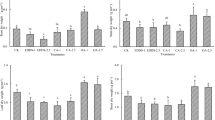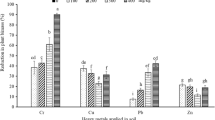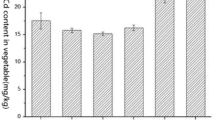Abstract
Cadmium and arsenic are two of the most important and toxic pollutants ubiquitous in the environment. The occurrence of numerous polluted areas as the affected by the accident of Aznalcóllar pyrite mine has promoted the employment of the phytoremediation as a feasible technology able to control and reduce the risk of this contamination at low cost. White lupin plant is proposed as a candidate for phytoremediation. This work aims to study if it is possible to use white lupin in phytoremediation of soils affected by acid pyrite sludge, with simultaneous As and Cd pollution. Pot and field experiments with sludge-affected soil were carried out. The pot trial showed that the NTA treatment increased Cd and As concentrations in lixiviates, exceeding the maximum permissible levels, so that its use in field experiments was avoided. In the field experiment, phytoextraction of Cd and As by lupin plants was very low, suggesting that it was not recommended for phytoextraction. However, lupin culture in the field produced several benefits as: increase of acid soil pH probably by citrate excretion, decrease in soluble As and Cd fractions in soil, high concentration of As and Cd in roots with accumulation of heavy metals in root nodules. All these results support the use of Lupinus albus for phytostabilization and revegetation of the spill polluted soils.
Similar content being viewed by others
References
Aguilar, J., Dorronsoro, C., Fernández, E., Fernández, J., García, I., Martín, F., & Simón, M. (2004). Soil pollution by a pirite mine spill in Spain: evolution in time. Environ. Pollut, 132 395–401.
Aslying, H.C. (1964). Phosphate potential and phosphate status of soils. Acta Agr. Scand, 14 261–285.
Bargagli, R. (1998). Trace elements in terrestrial plants. An ecophysiological approach to biomonitoring and biorecovey. Springer-Verlag, Berlin.
Bender, F.E., Douglass, L.W., & Kramer, A. (1989). Statistical Methods for Food and Agriculture, Food Products Press, New York.
Bucheli-Witschel, M., & Egli, T. (2001). Environmental fate and microbial degradation of aminopolycarboxylic acids. FEMS Microbiol. Rev., 25 69–106.
Calvo de Anta, R., & Macías, F. (2004). Remediation of pyritic contaminated soils in Aznalcóllar (Sevilla, Spain). in: Faz, A., Ortiz, R., García, G. (Eds.), Invited lectures and abstracts Fourth Internacional Conference on Land Degradation, Quaderna Editorial, Spain, pp. 125–137.
Carpena, R.O., Vázquez, S., Esteban, E., Fernández-Pascual, M., de Felipe, M.R., & Zornoza, P. (2003). Cadmium-stress in white lupin: effects on nodule structure and functioning. Plant Physiol. Bioch., 41 911–919.
Chaney, R.L., Malik, M., Li, Y.M., Brown, S.L., Brewer, E.P., Angle, S., & Baker, A.J.M. (1997). Phytoremediation of soil metals. Curr. Opin. Biotech., 8 279–284.
Chiu K.K., Ye Z.H., & Wong M.H. (2005). Enhanced uptake of As, Zn and Cu by Vetiveria zizanioides and Zea mays using chelating agents. Chemosphere 60 1365–1375.
Clemente, R., Walker, D.J., & Bernal, M.P. (2005). Uptake of heavy metals and As by Brassica juncea grown in a contaminated soil in Aznalcóllar (Spain): The effect of soil amendments. Environ. Pollut, 138 46–58.
Cu, S.T.T., Hutson, J., & Schuller, K.A. (2005). Mixed culture of wheat (Triticum aestivum L.) with white lupin (Lupinus albus L.) improves the growth and phosphorus nutrition of the wheat. Plant Soil 272 143–151.
Dinkelaker, B., Romheld, V., & Marschner, H. (1989). Citric acid excretion and precipitation of calcium citrate in the rhizosphere of white lupin (Lupin albus L.). Plant Cell Environ 12 285–292.
Fitz, W.J., & Wenzel, W.W. (2002). Arsenic transformations in the soil-rhizosphere-plant system: fundamentals and potential application to phytoremediation. J. Biotechnol., 99 259–278.
García, G., Zanuzzi, A., & Faz, A. (2005). Evaluation of heavy metal availability prior to an in situ soil phytoremediation program. Biodegradation 16 187–194.
Grimalt, J.O., Fetter, M., Macphorson, F. (1999). The mine tailing accident in Aznalcollar. Sci. Total Environ., 242, 3–11
Hinsinger, P., Plassard, C., Tang, C., & Jaillard, B. (2003). Origins of root-mediated pH changes in the rhizosphere and their responses to environmental constraints: A review. Plant Soil 248 43–59.
Huyghe, C.H. (1997). White lupin (Lupinus albus L.). Field Crop. Res., 53 147–160.
Kabata-Pendias, A., & Pendias, H. (2001). Trace elements in soils and plants, CRC Press, Boca Raton, Florida, USA.
Kerley, S.J. (2000). Changes in root morphology of white lupin (Lupinus albus L.) and its adaptation to soils with heterogeneous alkaline/acid profiles. Plant Soil 218 197–205
Kulli, B., Balmer, M., Krebs, R., Lothenbach, B., Geiger, G., & Schulin, R. (1999). The influence of nitrilotriacetate on heavy metal uptake of lettuce and ryegrass. J. Environ. Qual., 28 1699–1705.
Lai., H., & Chen., Z. (2005). The EDTA effect on the phytoextraction of single and combined metals-contaminated soils using rainbow pink (Dianthus chinensis). Chemosphere 60 1062–1071.
Lozano-Rodríguez, E., Luguera, M., Lucena, J.J., & Carpena, R.O. (1995). Evaluation of two different acid digestion methods in closed systems for trace element determinations in plants. Quim. Anal., 14 27–30.
Madejón, P., Murillo, J.M., Marañón, T., Cabrera, F., & López, R. (2002). Bioaccumulation of As, Cd, Cu, Fe and Pb in wild grasses affected by the Aznalcóllar mine spill (SW Spain). Science Total Environ., 290 105–120.
MAPA. (1994). Métodos oficiales de análisis. Secretaría General Técnica, Ministerio de Agricultura, Pesca y Alimentación, Madrid, Spain.
Natural Resources Conservation Service (1999). Soil Taxonomy. A basic system of soil classification for making ind interpreting soil surveys, second ed. USDA, Washington, DC Pilon-Smits, E.: 2005, Phytoremediation. Annu. Rev. Plant Biol., 56 15–39.
Soltanpour, P.N., & Schwab, A.P. (1977). A new soil test for simultaneous extraction of macro-and micronutrients in alkaline soils. Commun. Soil Sci. Plant Anal., 8(3) 195–207.
Soudek, P., Podracká, E., Vagner, M., Vanek, T., Petrík, P., & Tykva, R. (2004). 226Ra uptake from soils into different plant species. J. Radioanal. Nucl. Ch., 262 187–189.
Taggart, M.A., Carlisle, M., Pain, D.J., Willliams, R., Osborn, D., Joyson, A., & Meharg, A.A. (2004). The distribution of arsenic in soils affected by the Aznalcóllar mine spill, SW Spain. Sci. Total Environ., 323 137–152.
Tassi, E., Pedron, F., Barbafieri, M., & Petruzzelli, G. (2004). Phosphate-assisted phytoextraction in As-contaminated soil. Eng. Life Sci., 4 341–346.
USEPA. (1997). Engineering Bulletin: Technology Alternatives for the Remediation of Soils Contaminated with As, Cd, Cr, Hg and Pb. Environmental Protection Agency, Office of Research and Development, Cincinati, OH, U.S.
Vassilev, A., Vangronsveld, J., & Yordanov, I. (2002). Cadmium phytoextraction: present state, biological backgrounds and research needs. Bulg. J. Plant Physiol 28 (3–4), 68–95.
Vázquez, S., Esteban, E., & Goldsbrough, P. (2005). Arsenate-induced phytochelatins in white lupin: influence of phosphate status. Physiol. Plantarum 124 42–50.
Vidal, M., López-Sánchez, J.F., Sastre, J., Jiménez, G., Dagnac, T., Rubio, R., & Rauret, G. (1999). Prediction ofthe impact of the Aznalcóllar toxic spill on the trace element contamination of agricultural soils. Sci. Total Environ., 242 131–148.
Wu, L.H., Luo, Y.M., **ng, X.R., & Christie, P. (2004). EDTA-enhanced phytoremediation of heavy metal contaminated soil with Indian mustard and associated potential leaching risk. Agr. Ecosyst. Environ., 102 307–318.
**ménez-Embún, P., Rodríguez-Sanz, B., Madrid-Albarrán, Y., & Cámara, C. (2002). Uptake of Heavy Metals by Lupin Plants in Artificially Contaminated Sand: Preliminary Results. Int. J. Environ. An. Ch., 82 (11/12) 805–14.
Zornoza, P., Vázquez, S., Esteban, E., Fernández-Pascual, M., & Carpena, R.O. (2002). Cadmium-stress in nodulated white lupin: strategies to avoid toxicity. Plant Physiol. Bioch., 4, 1003–1009.
Author information
Authors and Affiliations
Corresponding author
Rights and permissions
About this article
Cite this article
Vázquez, S., Agha, R., Granado, A. et al. Use of White Lupin Plant for Phytostabilization of Cd and As Polluted Acid Soil. Water Air Soil Pollut 177, 349–365 (2006). https://doi.org/10.1007/s11270-006-9178-y
Received:
Accepted:
Published:
Issue Date:
DOI: https://doi.org/10.1007/s11270-006-9178-y




